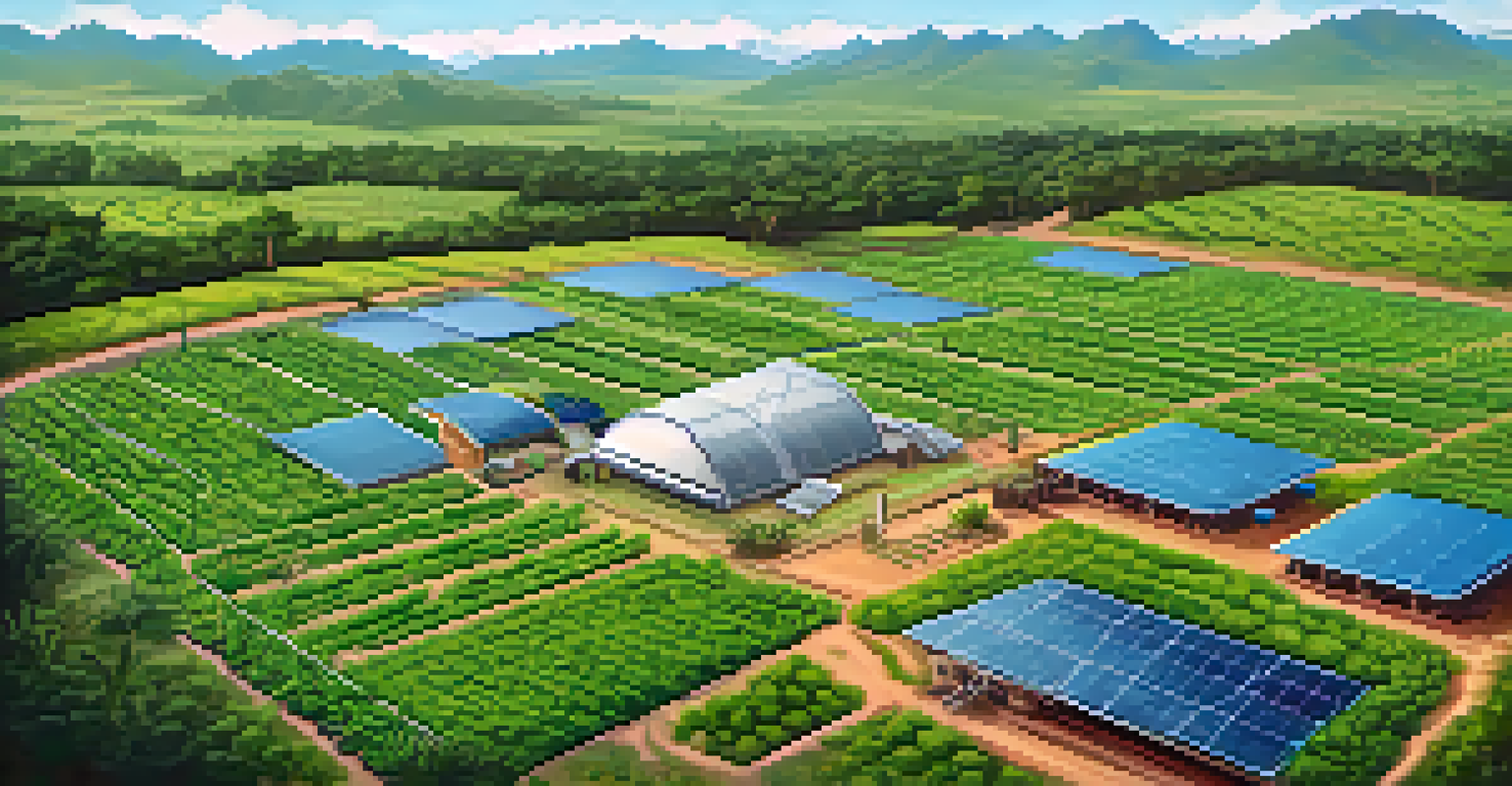Water Conservation Strategies for Sustainable Ayahuasca Farming

Understanding the Importance of Water in Ayahuasca Farming
Water is a vital resource in ayahuasca farming, impacting plant health and yield. Without adequate moisture, the sacred plants used in ayahuasca can suffer from stunted growth or even die, reducing the quality of the brew. Sustainable farming practices must prioritize water conservation to ensure the longevity of both the crops and the cultural practices surrounding them.
Water is the source of life, and it is essential for our survival and the sustainability of our environment.
In regions where ayahuasca is cultivated, water scarcity can be a pressing issue, especially with fluctuating climates. Farmers are increasingly aware that every drop counts, leading to innovative strategies that not only conserve water but enhance overall farming practices. Understanding the local water cycles can help farmers make informed decisions about irrigation and crop management.
Moreover, embracing water conservation can create a ripple effect, benefiting the entire ecosystem. By protecting water resources, farmers contribute to the health of their communities and the environment, fostering a sustainable relationship with nature. This holistic approach to ayahuasca farming is crucial for future generations.
Rainwater Harvesting: A Simple Solution
Rainwater harvesting is an age-old technique that has gained renewed attention in sustainable farming. By collecting and storing rainwater, ayahuasca farmers can reduce their dependency on groundwater sources, ensuring a more reliable water supply during dry spells. This method is not only cost-effective but also helps in managing stormwater runoff, reducing erosion.

Implementing rainwater harvesting systems can be as simple as installing gutters on structures to channel rainwater into storage tanks. This approach can significantly increase water availability, especially in regions with distinct wet and dry seasons. Additionally, using this collected water for irrigation can improve soil health and plant resilience.
Water is Crucial for Ayahuasca Farming
Adequate water resources are essential for the health and yield of ayahuasca plants, making water conservation practices vital.
Farmers who adopt rainwater harvesting often report enhanced crop performance and reduced irrigation costs. This practice is a win-win, allowing growers to nurture their sacred plants while conserving precious resources. Moreover, it encourages a deeper connection between farmers and their environment, fostering a sense of stewardship.
Drip Irrigation: Precision in Water Use
Drip irrigation is a highly efficient method of watering crops that delivers water directly to the plant roots. This technique minimizes evaporation and runoff, ensuring that every drop serves its purpose. For ayahuasca farmers, adopting drip irrigation can lead to significant savings in water and improved plant health.
The future will be a blend of tradition and innovation, and sustainability will be at its core.
By using a network of tubes and emitters, farmers can control the amount of water each plant receives, tailoring it to their specific needs. This precision not only conserves water but also reduces the risk of overwatering, which can lead to root rot and other health issues. Implementing drip irrigation can transform the way ayahuasca is cultivated, making it more sustainable.
In addition to conserving water, drip irrigation can enhance productivity and crop quality. Farmers who have made the switch often notice healthier plants and increased yields, supporting both their livelihood and cultural practices. Ultimately, this method exemplifies how technology can blend with tradition in sustainable farming.
Soil Management Techniques for Water Conservation
Healthy soil is the foundation of any successful farming operation, especially in ayahuasca cultivation. Implementing soil management techniques such as mulching and cover cropping can significantly enhance water retention. This means that during dry periods, the soil holds onto moisture longer, benefiting the plants.
Mulching involves covering the soil with organic materials, which not only conserves moisture but also suppresses weeds and improves soil health. On the other hand, cover crops are planted during off-seasons to protect the soil from erosion and enhance its nutrient profile. These practices create a robust ecosystem that supports sustainable ayahuasca farming.
Innovative Techniques for Sustainability
Methods like rainwater harvesting and drip irrigation can significantly enhance water efficiency and support sustainable ayahuasca cultivation.
Farmers who prioritize soil health often find that their crops require less water and are more resilient to climate variations. By investing in soil management, they contribute to a cycle of sustainability that benefits both their crops and the environment. This holistic approach is crucial for the future of ayahuasca cultivation.
Choosing Native Plant Varieties for Resilience
Selecting native plant varieties can be a game-changer for sustainable ayahuasca farming. These plants are naturally adapted to the local climate and soil conditions, making them more resilient to drought and pests. By cultivating native varieties, farmers can reduce their reliance on water and chemical inputs, leading to healthier ecosystems.
Native plants often require less water once established, allowing farmers to conserve resources while still producing high-quality ayahuasca. This not only benefits the environment but also aligns with traditional practices that honor the land. By embracing local biodiversity, farmers can create a more sustainable farming system.
Furthermore, using native varieties fosters a deeper connection to the cultural heritage of ayahuasca. It reinforces the importance of preserving local ecosystems and knowledge, ensuring that these practices are passed down through generations. This approach not only honors tradition but also promotes sustainability in the long term.
Integrating Agroforestry for Enhanced Water Conservation
Agroforestry, the practice of integrating trees and shrubs into agricultural landscapes, offers a multitude of benefits for ayahuasca farming. By planting trees alongside ayahuasca crops, farmers can improve water retention in the soil and create a microclimate that protects the plants from extreme weather. This symbiotic relationship fosters a healthier farming environment.
Trees play a crucial role in the water cycle by helping to regulate moisture levels. Their roots can reach deeper into the soil, accessing water that may be unavailable to surface plants. This not only conserves water but also enriches the soil with organic matter as leaves and branches decompose, promoting a rich ecosystem.
Community Collaboration Enhances Success
Engaging the community in water conservation efforts fosters shared knowledge and resilience, benefiting both farming practices and the environment.
Moreover, agroforestry practices can enhance biodiversity, attracting beneficial insects and wildlife that support crop health. Farmers who adopt this holistic approach often see improved yields and reduced water use, contributing to sustainable ayahuasca farming. By working with nature, rather than against it, they foster a resilient agricultural system.
Community Involvement in Water Conservation Efforts
Community involvement is essential for effective water conservation strategies in ayahuasca farming. By working together, farmers can share resources, knowledge, and innovative practices that benefit everyone. Collaborative efforts can lead to the development of community-wide irrigation systems, rainwater harvesting initiatives, and educational programs.
Organizing workshops and training sessions can empower farmers with the skills needed to implement sustainable practices. This creates a sense of ownership and responsibility towards water conservation, fostering a culture of sustainability. When communities come together, they can tackle challenges more effectively and adapt to changing environmental conditions.

Furthermore, engaging the community in conservation efforts builds resilience against climate change. By sharing successes and challenges, farmers can learn from one another and continuously improve their practices. This collective approach not only strengthens the farming community but also nurtures the land that sustains them.
The Future of Sustainable Ayahuasca Farming
The future of sustainable ayahuasca farming lies in the adoption of innovative water conservation strategies. As climate change continues to impact weather patterns, it is essential for farmers to adapt their practices to ensure the health of their crops and the environment. By embracing techniques such as rainwater harvesting, drip irrigation, and agroforestry, farmers can cultivate ayahuasca sustainably.
Moreover, the integration of community efforts and traditional knowledge enhances the resilience of farming systems. As farmers work together, they can share valuable insights and foster a culture of sustainability that benefits everyone. This collaborative approach ensures that the wisdom of past generations is preserved while adapting to modern challenges.
Ultimately, sustainable ayahuasca farming is not just about conserving water; it's about nurturing a deep connection to the land and its resources. By prioritizing sustainability, farmers can ensure that future generations can continue to cultivate these sacred plants, honoring their cultural heritage while protecting the environment.